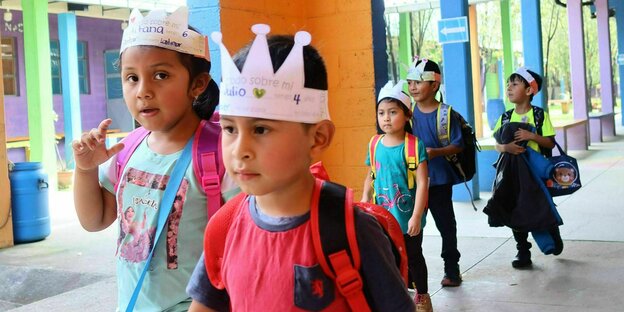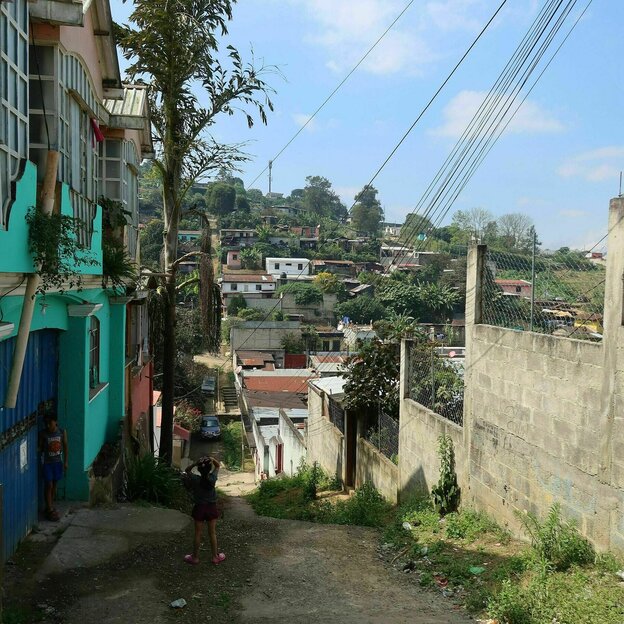In the city of Cobán in Guatemala, the “School of Hope” offers many children a perspective they would otherwise hardly have.

These children receive food and many other important offers at their school Photo: Knut Henkel
COBAN taz Byron Gómez and his team at the “School of Hope” in the Guatemalan city of Cobán have their hands full this Monday morning. Many parents, especially mothers, line up outside the office door. Today is registration day for the new school year that begins in August.
“We don't know if we will be able to meet the demand because there are not more than one hundred places available for preschool and primary school students,” says the director, who is around 30 years old, and the first ones have already left. Also to children from other parts of the city, such as the center of Cobán. That was not the case before.
“As a criminal, inhabited by garbage collectors, that is, people who make a living from recycling, artisans and simple people, Effort I does not have the best reputation even today, but we are making progress,” says the educator about the facility located on a hill in the Poor neighborhood. Gomez has been working at a slightly different school for more than eight years.
Today he is its director. “Here we work with children who often come from precarious backgrounds. Many of the parents make a living recycling at the landfill. Violence in the family is a huge problem and we try to help as much as we can,” explains Gómez.
This school can keep up
This works so well that, on average, young people from the “School of Hope” can keep up with children from schools in other parts of Cobán. This is guaranteed by a young and committed staff and the initiator of the school, Father Godoy. He has his office right next door. Sergio Godoy, a short and wiry man, with a well-kept short beard and very short hair, is a pragmatist at the service of the Lord.
In 2003 he was sent to Esfuerzo I as a young, curious priest with some teaching experience. “When I became familiar with my new community, I also visited the garbage dump: I saw children fighting over food from garbage bags, while dogs and vultures searched for carrion, and in between adults carrying plastic, glass and tin. and I collected cardboard boxes from the mountains of garbage that the trucks brought in,” recalls Godoy.
He was shocked and returned the next day with a pot of soup and a soccer ball. After playing soccer with the children and young people, he invited them to dinner and made his first contacts. A few weeks later, the spontaneous initiative became a regular Saturday gathering where people played, ate, and soon taught.

View of Esfuerzo I, the poor neighborhood of the city of Cobán in Guatemala, which through persistent work became the “City of Hope.” Photo: Knut Henkel
“The idea arose of founding a school for those who the authorities had left to their fate,” said the critical pastor. He is committed to a more just and supportive society, has established contacts mainly with ecclesiastical organizations in the country and abroad and has thus obtained initial financing. The city provided the land on the hill above Effort I.
Food from your own garden.
“From the beginning it was clear that we would also pay for the children's food. It is difficult to study on an empty stomach,” explains Father Godoy with a charming smile. Godoy's team has stuck to this all these years. In front of the brick wall several hundred meters long that separates the school from the street is the vegetable gardenthe orchard.
Pumpkins, zucchini, fruits, but also some corn, a staple food in Guatemala along with beans, are grown along with many other things. Each morning, the 425 current students ages five to eighteen receive breakfast, a small snack, and lunch.
Cobán's somewhat different school celebrated its 20th anniversary last year and has slowly opened up to other parts of the city over the years. What started out as a purely neighborhood school is now open to other families, and mothers like Violeta Cierra, who lives in the center of the city of 90,000 inhabitants, have taken advantage of the opportunity.
“I have only heard good things, I trust the young, committed and communicative staff, which many public schools can only dream of,” says this woman in her early thirties. Several women in line agree with her. She has no worries, although she knows that the “School of Hope” teaches many children from precarious backgrounds. “The staff is experienced and not alone. Here is a psychological office, a doctor with a hospital ward, what school has something like that? ”She asks with a friendly smile.
Money for schools does not arrive
Guatemala occupies last place in the PISA test. A key reason for this is corruption: money goes to schools. Furthermore, in almost no other country in Latin America were schools closed for as long due to the pandemic as in the largest country in Central America: two full years. This has brought a lot of criticism to the conservative president, Alejandro Giammattei, who has just left office, and even more so that the damage, necessary repairs and maintenance have not been attended to in the two years of paralysis.
For the political leaders of their country, several of the women in line only wave their hands in contempt. The same happens with Father Godoy, who receives from the State around eighty percent of the operating expenses of his School of Hope, but the rest has to be financed with donations, mostly from abroad, for medical, psychological or other help. for the small human rights office. “We need this integrative and inclusive approach,” the cleric said.
This need becomes evident “in family crises, for example,” explains María del Rosario Piñera, who for a few years has coordinated the human rights work of the “City of Hope” and who initially directed the school. Today she is responsible for domestic and sexual violence, both problems in the Effort I district.
Suspected children and young people are interviewed and children and adolescents from families in crisis can, if necessary, be placed in a supervised apartment, says Piñera. Furthermore, the 27-year prison sentence of a father for abusing his three daughters in Effort I had a positive and deterrent effect. Successes like this help children, adolescents and also mothers move with more confidence in Effort I.
“I want to be a lawyer”
An example is Gloria, who meets her cousin Anderson in front of the classroom to go home together. This bright twelve-year-old girl knows exactly that she wants to study law in five or six years: “Law! “I want to be a lawyer,” she says and looks around her with confidence. Professor Narda Pop Cucul, who is sorting classwork on a bench across the street, nods approvingly.
The young educator from the indigenous community has been working at the project school since 2020, feels comfortable with an extremely supportive staff and has the feeling that she is in the right place. “I learn a lot from the children and improve. “It's very satisfying,” she explains. As Paolo Casado believes, he reciprocates: “This school gives me many options. “Here I have many possibilities of getting a scholarship to train in the restaurant sector in a hotel,” she says gratefully.
Paola reports that she has also become much more confident in the “City of Hope.” She attributes this to the support of 24 dedicated teachers, including ten men, and modern pedagogical concepts. This also has an impact on Esfuerzo I, where more and more small businesses have emerged and where construction works are being carried out.
Evidence of a rebound that can also be observed in the garbage dump and its surroundings. The goal is to make it more modern and sustainable, and the plan is not only to install drainage systems to remove contaminated wastewater from the landfill, but also to separate the waste and install a composting system for organic waste.
According to the city administration, this is progress that will be notable for those families who depend on garbage collection. A consequence of 20 years of continuous work in the “City of Hope”.